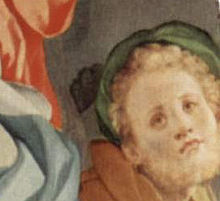The Deposition from the Cross (Pontormo)
| Deposition from the Cross | |
|---|---|
| Italian: Deposizione | |
Jacopo Pontormo | |
| Year | c. 1525–1528 |
| Type | Tempera on wood |
| Dimensions | 313 cm × 192 cm (123 in × 76 in) |
| Location | Church of Santa Felicita, Florence |
The Deposition from the Cross is an
Interpretation
This painting suggests a whirling dance of the grief-stricken. They inhabit a flattened space, comprising a sculptural congregation of brightly demarcated colors. The vortex of the composition droops down towards the limp body of Jesus off center in the left. Those lowering Christ appear to demand our help in sustaining both the weight of his body (and the burden of sin Christ took on) and their grief. No cross is visible; the natural world itself also appears to have nearly vanished: a lonely cloud and a shadowed patch of ground with a crumpled sheet provide sky and stratum for the mourners. If the sky and earth have lost color, the mourners have not; bright swathes of pink and blue envelop the pallid, limp Christ.[citation needed]
Pontormo's undulating

This painting plays a key role and is discussed extensively in Sarah Winman's novel, Still Life.[citation needed]
Other works
The
Pontormo's grieving crowds and brightness of color also provide a stark contrast to
In addition to works of the same subject by other artists, Pontormo's own work from the time provides a useful comparison. The decoration in the dome of the Capponi chapel is now lost, but four
References
| External videos | |
|---|---|
- ^ For an historiographic look at the use of the term mannerism see Craig Hugh Smyth, "Manerism and Maniera" (1963), reprinted in Liana de Girolami Cheney, ed, Readings in Italian Mannerism, with foreword by Craig Hugh Smyth (New York: Peter Lang, 1997, 2004), pp. 69-112.
- ^ Digital reproduction
- ^ "Pontormo's Entombment". Smarthistory at Khan Academy. Archived from the original on October 20, 2014. Retrieved January 8, 2013.
External links
- The Metropolitan Museum of Art
- Louis Alexander Waldman, "New light on the Capponi Chapel in S. Felicita," The Art Bulletin, June, 2002 [1]
